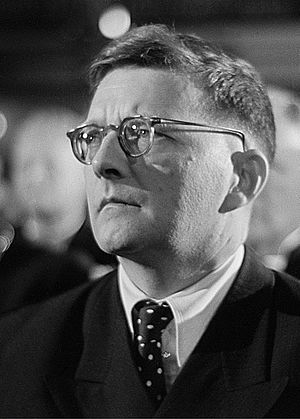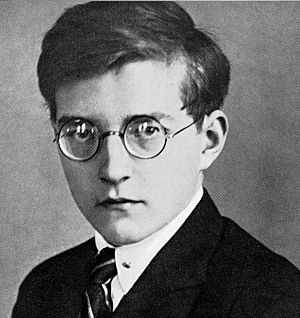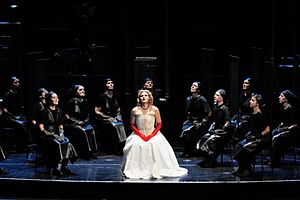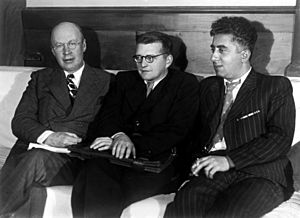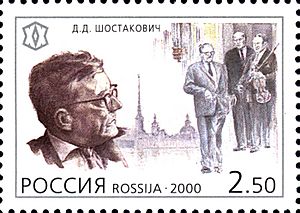Dmitri Shostakovich facts for kids
Dmitri Dmitriyevich Shostakovich (born September 25, 1906 – died August 9, 1975) was a famous Russian composer and pianist. He became known around the world after his First Symphony was first performed in 1926. Many people thought he was a very important composer throughout his life.
Shostakovich became famous early in the Soviet Union. However, he had a difficult relationship with the government. His opera Lady Macbeth of Mtsensk was popular at first. But then, the Soviet government criticized it, which put his career at risk. Later, in 1948, his music was again criticized by the government. This caused problems for his career for several years. Even after the criticism was lifted in 1956, his music sometimes faced government interference. For example, his Thirteenth Symphony (1962) caused some issues. Shostakovich was also a member of important government groups. He received several important awards from the Soviet government, like the Order of Lenin.
Shostakovich used many different musical styles in his works. His music often has strong contrasts and sometimes sounds a bit strange or funny. He was also inspired by older musical styles, like neoclassicism, and by the music of Gustav Mahler. He wrote 15 symphonies and six concertos for orchestra. He also wrote 15 string quartets, a piano quintet, and two piano trios for smaller groups of instruments. For solo piano, he wrote two sonatas and two sets of preludes and fugues. He also created three complete operas and three ballets. Shostakovich wrote many song cycles and a lot of music for plays and movies.
After he died, Shostakovich's fame continued to grow. People became very interested in his music and his life, especially how his music related to the Soviet government.
Contents
Dmitri Shostakovich's Early Life
Growing Up in Saint Petersburg
Dmitri Shostakovich was born in Saint Petersburg, Russian Empire. He was the second of three children. His father, Dmitri Boleslavovich Shostakovich, was an engineer. His mother, Sofiya Vasilievna Kokoulina, was also from Siberia. Dmitri's family had roots in Poland and Siberia. His grandfather was exiled to Siberia for being a revolutionary.
Dmitri showed great musical talent from a young age. He started piano lessons with his mother when he was nine. He could remember what his mother played very easily. In 1918, he wrote a funeral march for two political leaders who were killed.
Studying Music at the Conservatory
In 1919, when he was 13, Shostakovich was accepted into the Petrograd Conservatory. This was a famous music school. Alexander Glazunov, a well-known composer, was the head of the conservatory and watched Dmitri's progress closely. Shostakovich studied piano, composition, and other musical subjects there. In 1925, he even conducted Beethoven's First Symphony with the conservatory orchestra.
His music was first played in Moscow in 1925, but it wasn't very popular then. During this visit, he met Mikhail Tukhachevsky, a military leader, who helped him find a place to stay and work.
His First Big Success
Shostakovich's big musical breakthrough was his First Symphony. He wrote it as his graduation piece when he was 19. At first, he only wanted to play it for a small group. But his teachers and friends convinced Nikolai Malko to conduct its first public performance.
On May 12, 1926, the symphony was performed by the Leningrad Philharmonic Orchestra. The audience loved it and even asked for one part to be played again! After this, Shostakovich always remembered this date as the start of his symphonic career.
Early Career and Challenges
A Composer and Pianist
After graduating, Shostakovich started working as both a concert pianist and a composer. However, some people criticized his piano playing style. He performed a lot until 1930, but after 1933, he mostly played only his own music.
In 1927, he took part in an international piano competition in Warsaw. He got appendicitis on the first day, but he still played. He didn't win a prize, but he did get a diploma. He was a bit disappointed, but he still wanted to continue performing for a while.
After the competition, Shostakovich met the conductor Bruno Walter in Berlin. Walter was so impressed by Shostakovich's First Symphony that he conducted its first performance outside Russia later that year. Leopold Stokowski also performed it in America and made the first recording.
New Symphonies and Operas
In 1927, Shostakovich wrote his Second Symphony, called To October. It was a patriotic piece for the Soviet Union. But because it was very modern, it wasn't as popular as his First Symphony. This year also marked the start of a close friendship with music expert Ivan Sollertinsky. Shostakovich said Sollertinsky taught him to love great composers like Gustav Mahler.
While working on his Second Symphony, Shostakovich also started an opera called The Nose, based on a story by Nikolai Gogol. This opera was very modern and was criticized by some groups. It opened in 1930 to mixed reviews.
In the late 1920s and early 1930s, Shostakovich worked at a youth theater. This job helped protect him from political attacks. During this time, he also wrote his opera Lady Macbeth of Mtsensk, which was first performed in 1934. It was a big success at first, both with the public and with officials.
In 1932, Shostakovich married Nina Varzar. They divorced in 1935 but soon remarried when Nina became pregnant with their first child, Galina.
Challenges and Comebacks
The First Government Criticism
In January 1936, Joseph Stalin, the leader of the Soviet Union, watched a performance of Lady Macbeth of Mtsensk. He and his group left without saying anything. The next day, a major newspaper, Pravda, published an article called "Muddle Instead of Music". It said the opera was confusing and unpleasant. This article started a nationwide campaign against Shostakovich. Even critics who had praised the opera were forced to change their minds.
This criticism caused Shostakovich's income to drop a lot. Many of his friends and family were also arrested or killed during this difficult time, known as the Great Terror. His daughter Galina was born in 1936, and his son Maxim was born two years later.
Withdrawing the Fourth Symphony
Around the time of the Pravda articles, Shostakovich was writing his Fourth Symphony. This work was influenced by Gustav Mahler and was very complex. Even with the criticism, he continued to compose it. Rehearsals began, but Shostakovich was advised to withdraw the symphony, which he did. He didn't give up on the work, and it was finally performed in 1961.
The Fifth Symphony and Return to Favor Shostakovich's answer to the criticism was his Fifth Symphony in 1937. This symphony was more traditional than his earlier works. It was first performed on November 21, 1937, and was a huge success. Many people in the audience were deeply moved.
This success helped Shostakovich regain his good standing. Critics and authorities said he had learned from his mistakes and become a true Soviet artist. He also started teaching composition at the Leningrad Conservatory, which gave him some financial stability.
World War II and Its Impact
In 1941, when war broke out between the Soviet Union and Germany, Shostakovich stayed in Leningrad. He tried to join the military but was turned away because of his poor eyesight. Instead, he became a volunteer firefighter for the Leningrad Conservatory and gave a radio broadcast to the Soviet people.
Shostakovich's most famous work from this time was his Seventh Symphony. He wrote the first three parts in Leningrad while it was under siege. He finished the work after he and his family were moved to Kuybyshev. He said he continued working on it to show everyone that they had a "soldier's duty" to keep life going. The symphony was performed in London and the United States, and later in Leningrad itself while the city was still under siege.
In 1943, his family moved to Moscow. His Eighth Symphony, written during this time, had a sad tone, which surprised some people.
Shostakovich had planned a grand Ninth Symphony to finish his wartime series. But in 1945, he composed a different Ninth Symphony. It was shorter and lighter. Some officials criticized it for not being serious enough for the end of the war. He also wrote his Second Piano Trio, which had a Jewish-inspired ending.
The Second Government Criticism
In 1948, Shostakovich and other composers were again criticized for their music. This was part of a campaign against "formalism," which meant music that was too Western or not "Russian" enough. Composers were told to write only "proletarian" music, meaning music for the common people. Shostakovich and others had to apologize publicly. Most of his works were banned, and his family lost some privileges. He even waited by the elevator at night, so his family wouldn't be disturbed if he was arrested.
During this time, Shostakovich wrote music for films to earn money. He also wrote official works to try and get back into the government's good graces. And he wrote serious works "for the desk drawer," meaning they couldn't be performed publicly yet. These included his Violin Concerto No. 1 and the song cycle From Jewish Folk Poetry. This song cycle was written during a difficult time for Jewish people in the Soviet Union.
In 1949, the rules on Shostakovich's music were relaxed a bit. He was asked to represent the Soviet Union at a peace congress in New York City. This was a difficult experience for him. He had to read a speech that was prepared for him. He was asked if he supported the criticism of Igor Stravinsky's music in the Soviet Union. Even though he admired Stravinsky, he had to say yes. This showed that he was not free to speak his mind. That same year, he had to compose a cantata called Song of the Forests, which praised Stalin.
A New Era and New Music
When Stalin died in 1953, it was a big step towards Shostakovich being accepted again as a creative artist. This was shown in his Tenth Symphony. This symphony uses musical codes and is thought by some to be a musical picture of Stalin. The Tenth Symphony is one of his most popular works. Many of his "desk drawer" works were also performed for the first time in 1953.
Shostakovich had close relationships with two of his students, Galina Ustvolskaya and Elmira Nazirova. In 1956, he married his second wife, Margarita Kainova, but they divorced five years later.
In 1954, Shostakovich wrote the Festive Overture. This piece was later used as the theme music for the 1980 Summer Olympics.
Later Life and Legacy
Joining the Communist Party
In 1960, Shostakovich joined the Communist Party. The government wanted him to lead the RSFSR Union of Composers, and for that, he needed to be a Party member. Some people saw this as a sign of commitment, others as a result of pressure. His son remembered that Shostakovich cried about it and felt pressured. By joining the Party, he also agreed to write a piece honoring Lenin. His Twelfth Symphony, completed in 1961, was dedicated to Lenin and called "The Year 1917."
Shostakovich's musical response to these personal challenges was his Eighth String Quartet. He wrote it in just three days. He dedicated it "To the victims of fascism and war," but it also included musical references to his own life and earlier works. He told a friend, "I started thinking that if some day I die, nobody is likely to write a work in memory of me, so I had better write one myself."
In 1962, Shostakovich married his third wife, Irina Supinskaya. This marriage was a very happy one for him. That same year, he conducted publicly for the only time in his life.
Also in 1962, Shostakovich wrote his Thirteenth Symphony, called Babi Yar. This symphony used poems by Yevgeny Yevtushenko, one of which remembered a massacre of Ukrainian Jews during World War II. This was a sensitive topic, and after the symphony's first performance, the poem had to be changed slightly.
In 1965, Shostakovich spoke out to defend the poet Joseph Brodsky, who had been sentenced to exile. Shostakovich and other artists protested, and Brodsky's sentence was reduced.
Health and Final Works
In his later years, Shostakovich suffered from poor health. He had a serious illness that affected his right hand, making it hard for him to play the piano. He also had heart attacks and broke both his legs. He once joked in a letter that he only needed to hurt his left hand to have all his limbs out of order.
His later works, like his last string quartets and the Fourteenth Symphony (1969), often dealt with the idea of death. The Fourteenth Symphony was very experimental in its musical style. He dedicated it to his friend Benjamin Britten. His Fifteenth Symphony (1971) was more melodic and looked back at earlier music, quoting other composers and his own Fourth Symphony.
Even with his illness, Shostakovich insisted on writing all his own letters and music. His last work was his Viola Sonata, which was first performed in October 1975.
Dmitri Shostakovich died of heart failure on August 9, 1975, in Moscow. He was buried in the Novodevichy Cemetery.
Shostakovich made several recordings of his own piano music. Other famous musicians, like Mstislav Rostropovich and David Oistrakh, also played his music.
Shostakovich's music has become very popular over time, both in Russia and around the world. His influence can be seen in some composers, especially in Russia. The Shostakovich Peninsula in Antarctica was named after him.
Shostakovich's Music
What His Music Sounds Like
Shostakovich's music mostly uses traditional tonal sounds, but he also used elements of atonality and chromaticism, which means using notes outside the main key. In some of his later works, he even used tone rows, which is a more modern way of organizing notes.
His most important works are his 15 symphonies and 15 string quartets. The symphonies were written throughout his career, while most of the quartets were written later in his life. Some of his most popular pieces are the Fifth and Seventh Symphonies, and the Eighth and Fifteenth Quartets.
He also wrote operas like Lady Macbeth of Mtsensk and The Nose, six concertos, two piano trios, and a lot of music for films.
Who Influenced His Music
Shostakovich's music shows the influence of many composers he admired:
- Bach: You can hear Bach's influence in his fugues and passacaglias (types of musical forms).
- Beethoven: Especially in his later quartets.
- Mahler: His symphonies were a big influence on Shostakovich's symphonies.
- Berg: Shostakovich learned from Berg how to use musical codes and quotations in his works.
- Modest Mussorgsky: Shostakovich admired Mussorgsky's operas and even reorchestrated some of them. Mussorgsky's influence can be heard in the sad parts of Lady Macbeth and the Eleventh Symphony.
- Prokofiev: Prokofiev's style influenced Shostakovich's early piano works.
Shostakovich had mixed feelings about Igor Stravinsky. He said, "Stravinsky the composer I worship. Stravinsky the thinker I despise." He especially loved Stravinsky's Symphony of Psalms.
Before the 1936 criticism, Shostakovich's music was more experimental. He said that without government "guidance," he would have used more sarcasm and shown his ideas more openly. After 1936, his music became more traditional. He also wrote more chamber music (music for small groups of instruments). His later chamber works sometimes used tone rows, but in his own unique way. He also wrote many vocal works in his later years.
Jewish Themes in His Music
In the 1940s, Shostakovich became interested in Jewish themes in music. He was fascinated by how Jewish music could create a happy tune from sad sounds. You can hear Jewish themes in his Fourth String Quartet (1949), First Violin Concerto (1948), and the Piano Trio in E minor (1944).
In 1948, he found a book of Jewish folk songs and used them to compose the song cycle From Jewish Folk Poetry. He wrote eight songs about the difficulties of being Jewish in the Soviet Union. To hide this, he added three more songs that seemed to show a good life for Jews under the Soviet government. Even with his efforts, the music was not approved in 1949 due to anti-Jewish feelings in the country. From Jewish Folk Poetry could only be performed after Stalin's death in 1953.
Quoting Himself in Music
Shostakovich often used musical quotations in his compositions, but he mostly quoted his own music. This became a special part of his style.
For example, the main tune from Katerina's song in the opera Lady Macbeth of Mtsensk District is a beautiful melody. This tune becomes sad when her lover betrays her. More than 25 years later, Shostakovich used this same tune in his Eighth String Quartet. It appears again in his Fourteenth String Quartet, dedicated to a cellist named Sergei Shirinsky.
Newly Discovered Music
In 2004, a music expert named Olga Digonskaya found many of Shostakovich's old musical notes and sketches in a museum in Moscow. Among these were his notes for a part of an opera called Orango from 1932. These were later arranged by another composer and performed for the first time in 2011.
Shostakovich's Personality
Shostakovich was a very particular person. His daughter said he was "obsessed with cleanliness." He would set all the clocks in his home to the exact same time. He even sent himself postcards to check how well the postal service was working! Many people remembered him as being nervous and sensitive.
When he was in a lighter mood, he enjoyed sports, especially watching or being a referee in football games. His favorite football team was Zenit Leningrad. He also liked playing card games.
Shostakovich enjoyed writers who used satire, like Nikolai Gogol and Mikhail Zoshchenko. Zoshchenko noted that Shostakovich had different sides to his personality: he could be fragile and innocent, but also very smart and strong.
Shostakovich was naturally shy and found it hard to say "No" to people. This sometimes meant he signed official statements, even if he didn't fully agree with them. However, he tried to help many people through his roles in the Composers' Union and the government. When asked if he believed in God, he said, "No, and I am very sorry about it."
Recordings of His Music
In 1958, Shostakovich recorded his two piano concertos in Paris. He also recorded some of his other piano works. He later recorded the two concertos again in Moscow. Shostakovich also played the piano in recordings of his Cello Sonata and Violin Sonata. There is also an old film of him playing his first piano concerto in the 1930s. A color film was also made in 1974 showing him overseeing a new performance of his opera The Nose.
Awards and Honors
From the Soviet Union
- Hero of Socialist Labour (1966)
- Order of Lenin (1946, 1956, 1966)
- Order of the October Revolution (1971)
- Order of the Red Banner of Labour (1940)
- People's Artist of the RSFSR (1948)
- People's Artist of the USSR (1954)
- International Peace Prize (1954)
- Lenin Prize (1958 – for his Symphony No. 11 "The Year 1905")
- Stalin Prize (1941 – for Piano Quintet; 1942 – for Symphony No. 7; 1946 – for Piano Trio No. 2; 1950 – for Song of the Forests and film music; 1952 – for Ten Poems on Texts by Revolutionary Poets)
- USSR State Prize (1968 – for the cantata The Execution of Stepan Razin)
- Glinka State Prize of the RSFSR (1974 – for String Quartet No. 14 and choral cycle Loyalty)
- Shevchenko National Prize (1976, after his death – for the opera Katerina Izmailova)
Other Awards
- Member of the Royal Academy of Science, Letters and Fine Arts of Belgium (1960)
- Léonie Sonning Music Prize (1973)
- Wihuri Sibelius Prize (1958)
- Gold Medal of the Royal Philharmonic Society (1966)
In 1962, he was nominated for an Academy Award for his music in the film Khovanshchina (1959).
Images for kids
See Also
 In Spanish: Dmitri Shostakóvich para niños
In Spanish: Dmitri Shostakóvich para niños


